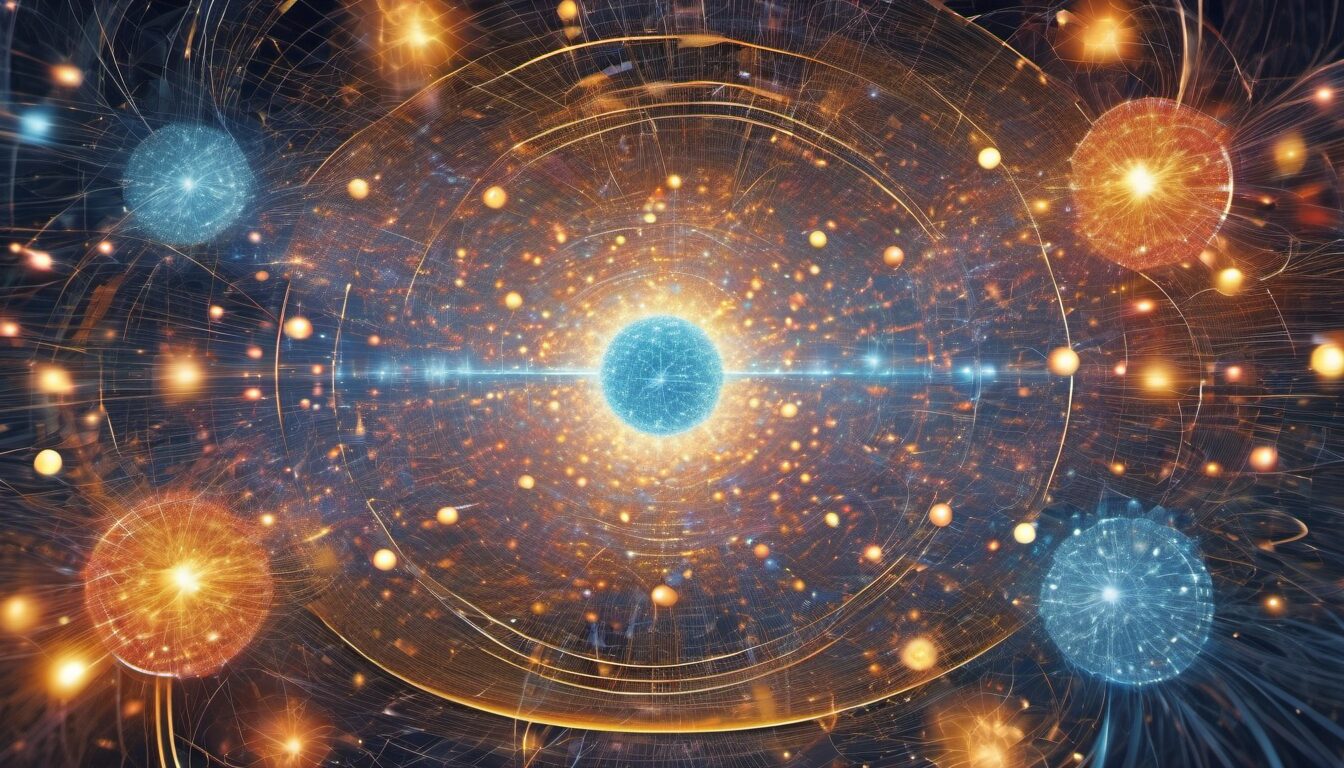Nuclear astrophysics stands as a vital discipline at the intersection of nuclear physics and astrophysics, offering invaluable insights into the profound workings of the cosmos. Through meticulous study and analysis, nuclear astrophysicists illuminate the intricate interplay between matter and energy, shedding light on the origins, evolution, and dynamics of celestial bodies spanning from individual stars to entire galaxies. This article embarks on a comprehensive exploration of the central role played by nuclear physics in unraveling the mysteries of the universe, delving into the mechanisms of nuclear reactions within stellar cores, the processes of nucleosynthesis responsible for the creation of elements, and the profound implications for our understanding of cosmic phenomena.
At the heart of nuclear astrophysics lies the study of nuclear reactions occurring within the cores of stars. These reactions, driven by the immense temperatures and pressures characteristic of stellar interiors, are the primary sources of energy that sustain stars throughout their lifetimes. Through the fusion of light nuclei into heavier elements, stars release vast amounts of energy, fueling their luminosity and radiating heat and light into the cosmos. By modeling and simulating these nuclear processes, nuclear astrophysicists gain crucial insights into the internal structure and evolution of stars, enabling predictions of stellar lifecycles and behaviors across various stages of stellar evolution.
Furthermore, nuclear astrophysics plays a pivotal role in elucidating the processes of nucleosynthesis—the formation of chemical elements within stars and other celestial environments. As stars evolve and undergo nuclear fusion, they synthesize elements ranging from hydrogen and helium to heavier elements like carbon, oxygen, and beyond. These elements are subsequently dispersed into the interstellar medium through stellar winds, supernova explosions, and other cosmic phenomena, enriching galaxies with a diverse array of chemical elements. Through observational studies of stellar spectra and isotopic abundances, nuclear astrophysicists trace the origins of elements and unravel the complex pathways of nucleosynthesis, deepening our understanding of the cosmic abundance of elements and the evolution of chemical composition in the universe.
Moreover, nuclear astrophysics provides critical insights into the origins of the most fundamental building blocks of matter—the protons and neutrons that comprise atomic nuclei. By probing the behavior of nuclear matter under extreme conditions of temperature and density, nuclear astrophysicists explore the genesis of these elementary particles and their role in shaping the universe. Through experiments conducted in laboratories and astrophysical simulations, researchers unravel the mysteries of nuclear interactions, neutron capture processes, and nucleosynthesis pathways, offering profound insights into the fundamental nature of matter and energy in the cosmos.
Nuclear astrophysics stands as a cornerstone of scientific inquiry, offering a window into the cosmic symphony that surrounds us. By unraveling the mysteries of nuclear reactions, nucleosynthesis processes, and the origins of elements, nuclear astrophysics deepens our understanding of the universe’s structure, evolution, and dynamics, paving the way for groundbreaking discoveries and advancements in our exploration of the cosmos.
Foundations of Nuclear Astrophysics:
Nuclear astrophysics stands as a pivotal discipline at the intersection of nuclear physics and astrophysics, delving into the profound mechanisms that govern the behavior of matter and energy within the cosmos. To understand the intricate dance of stars, galaxies, and the universe at large, it’s essential to grasp the foundational principles of nuclear physics and their implications for stellar evolution and cosmic dynamics.
At its core, nuclear astrophysics begins with an exploration of nuclear physics—the study of the structure, properties, and interactions of atomic nuclei. Nuclei, composed of protons and neutrons bound together by strong nuclear forces, form the fundamental building blocks of matter within stars and other celestial bodies. Understanding the dynamics of nuclear interactions, the stability of nuclei, and the processes of nuclear reactions provides the theoretical framework for unraveling the mysteries of stellar phenomena.
Stellar evolution serves as a central focus of nuclear astrophysics, tracing the life cycles of stars from their formation to their eventual demise. Stars are born within dense molecular clouds through the gravitational collapse of gas and dust, initiating nuclear fusion reactions in their cores as they ignite into luminous spheres of plasma. Throughout their lifetimes, stars undergo a series of stages dictated by their mass, luminosity, and composition, culminating in spectacular events such as supernova explosions or the formation of compact remnants like white dwarfs, neutron stars, or black holes. By studying the various stages of stellar evolution, nuclear astrophysicists gain insights into the physical processes driving the life cycles of stars and the formation of diverse celestial objects.
Nuclear processes play a fundamental role in shaping the energy production, thermal balance, and chemical composition of stars. Within the cores of stars, nuclear fusion reactions convert lighter elements into heavier ones, releasing vast amounts of energy in the process. The fusion of hydrogen nuclei into helium, known as stellar nucleosynthesis, powers the luminosity of stars like the Sun and generates the elements essential for the formation of planets, moons, and life itself. Additionally, nuclear reactions involving heavier elements contribute to the energy generation in more massive stars and drive processes such as stellar explosions and nucleosynthesis beyond helium.
In summary, the foundations of nuclear astrophysics rest upon a deep understanding of nuclear physics principles and their application to the study of stellar evolution and cosmic phenomena. By exploring the dynamics of nuclear reactions, the life cycles of stars, and the importance of nuclear processes in stellar energy production, nuclear astrophysicists unravel the mysteries of the universe and gain insights into the fundamental processes that govern its evolution and dynamics.
Nuclear Reactions in Stellar Interiors:
Nuclear reactions within stellar interiors serve as the engines that drive the energy production, thermal balance, and chemical evolution of stars. In this section, we explore the fascinating world of nuclear fusion processes occurring within the cores of stars, from the hydrogen fusion that powers main sequence stars to the advanced fusion reactions that occur in the cores of evolved stars.
Hydrogen Fusion in Main Sequence Stars: Main sequence stars, such as the Sun, derive their energy primarily from the fusion of hydrogen nuclei into helium through two main processes: the proton-proton (PP) chain and the CNO cycle. In the PP chain, four hydrogen nuclei (protons) undergo a series of fusion reactions, ultimately yielding a helium nucleus along with energy in the form of gamma rays and positrons. The CNO cycle, prevalent in more massive stars, utilizes carbon, nitrogen, and oxygen isotopes as catalysts to convert hydrogen into helium, releasing energy in the process. These fusion processes sustain the luminosity and stability of main sequence stars, providing the energy necessary to counteract gravitational collapse.
Helium Burning and Beyond: As main sequence stars exhaust their hydrogen fuel, they enter subsequent stages of nuclear fusion, known as helium burning and beyond. In the cores of evolved stars such as red giants and supernovae progenitors, helium fusion reactions play a crucial role in powering their luminosity and driving their evolution. The triple-alpha process, involving the fusion of three helium nuclei (alpha particles) to form carbon, serves as the primary helium-burning mechanism in stars with sufficiently high core temperatures. Beyond helium burning, stars with even higher mass and core temperatures may undergo successive stages of nuclear fusion, synthesizing heavier elements such as oxygen, neon, and magnesium. These advanced fusion reactions contribute to the chemical enrichment of the interstellar medium and the eventual formation of new stars and planetary systems.
Neutrino Production: In addition to gamma rays and other forms of radiation, nuclear reactions in stellar interiors also produce copious amounts of neutrinos—elusive, nearly massless particles that interact weakly with matter. Neutrinos play a crucial role in carrying away excess energy generated by nuclear fusion reactions, thereby influencing the thermal balance and evolutionary pathways of stars. Moreover, neutrinos provide valuable insights into stellar dynamics and nucleosynthesis processes, as their detection and analysis enable astronomers to probe the inner workings of stars and decipher their fundamental properties.
In summary, nuclear reactions in stellar interiors represent the fundamental processes that govern the energy production, thermal balance, and chemical evolution of stars. From hydrogen fusion in main sequence stars to advanced fusion reactions in evolved stars, these nuclear processes shape the life cycles and dynamics of stars across the cosmos, shedding light on the intricate interplay between matter, energy, and the forces of nature.
Stellar Nucleosynthesis:
Stellar nucleosynthesis encompasses the processes by which elements are synthesized within stars, shaping the chemical composition of the cosmos. In this section, we delve into the various pathways of nucleosynthesis, from the formation of light elements in the early universe to the production of heavy elements through stellar evolution and cataclysmic events.
Primordial Nucleosynthesis:
During the first few minutes after the Big Bang, the universe was a hot, dense soup of elementary particles and radiation. As the universe expanded and cooled, the conditions became conducive to nuclear reactions, leading to the synthesis of light elements in a process known as primordial nucleosynthesis. The dominant reactions during this epoch involved the fusion of protons and neutrons to form the lightest elements: hydrogen, helium, and traces of lithium. The abundance of these primordial elements, as inferred from observations of the cosmic microwave background radiation, provides valuable insights into the early universe’s conditions and evolution.
Stellar Nucleosynthesis Pathways:
Inside stars, nucleosynthesis proceeds through a series of fusion reactions that convert lighter elements into heavier ones. In main sequence stars like the Sun, hydrogen fusion gives rise to helium, while subsequent stages of fusion generate elements up to carbon and oxygen. For heavier elements beyond iron, nucleosynthesis pathways diverge, depending on the stellar environment and conditions. The slow neutron capture process (s-process) occurs in the cores of evolved stars, where neutron capture reactions gradually build up heavier elements by capturing neutrons over long timescales. Conversely, the rapid neutron capture process (r-process) occurs in explosive environments such as supernova explosions or neutron star mergers, where neutron fluxes are high, leading to rapid neutron capture and subsequent beta decay. Another nucleosynthesis pathway, known as the proton capture process (p-process), occurs in explosive stellar environments and involves the capture of protons by existing nuclei to produce heavier elements.
Production of Heavy Elements:
The synthesis of heavy elements beyond iron poses a significant astrophysical puzzle, as these elements require high temperatures, densities, and neutron fluxes to form. Supernova explosions, occurring at the end of massive stars’ lives, are one of the primary sites for heavy element synthesis. During a supernova explosion, the extreme conditions generated by the stellar collapse and subsequent rebound facilitate rapid neutron capture and nucleosynthesis up to the heaviest elements. Additionally, neutron star mergers, rare cosmic events involving the collision of two neutron stars, are believed to be responsible for producing a substantial fraction of heavy elements in the universe, including gold, platinum, and uranium.
In summary, stellar nucleosynthesis encompasses a diverse array of processes that generate elements across the periodic table, from hydrogen and helium to the heaviest elements beyond iron. Through primordial nucleosynthesis, stellar evolution, and cataclysmic events such as supernovae and neutron star mergers, stars serve as cosmic alchemists, synthesizing the raw materials essential for the formation of planets, life, and the rich tapestry of the universe.
Nuclear Astrophysics in Galactic and Cosmological Context:
Nuclear astrophysics extends beyond individual stars to encompass the broader context of galaxies and the universe as a whole. In this section, we explore how nuclear processes influence the evolution of galaxies and contribute to our understanding of cosmic phenomena on a grand scale.
Galactic Chemical Evolution:
Galaxies are dynamic systems where stars form, evolve, and interact over billions of years. Galactic chemical evolution refers to the changes in the chemical composition of galaxies over cosmic time, driven by processes such as star formation, stellar nucleosynthesis, and galactic mergers. As stars undergo nucleosynthesis and release heavy elements into their surroundings through stellar winds and supernova explosions, galaxies gradually enrich their interstellar medium with metals (elements heavier than hydrogen and helium). Observations of the chemical composition of stars and galaxies across different cosmic epochs provide valuable insights into the history of cosmic chemical enrichment and the underlying processes shaping galactic evolution.
Cosmic Microwave Background Radiation:
The cosmic microwave background (CMB) radiation is the residual heat from the Big Bang, pervading the universe in all directions. Primordial nucleosynthesis, occurring within the first few minutes after the Big Bang, played a crucial role in determining the cosmic abundances of light elements such as hydrogen, helium, and lithium. The imprint of primordial nucleosynthesis on the CMB radiation provides a unique window into the early universe’s conditions and cosmological parameters, such as the baryon density, the Hubble constant, and the total mass-energy content of the universe. Observations of the CMB, such as those made by the Planck satellite, have yielded precise measurements of these cosmological parameters, constraining theoretical models of cosmic evolution and providing a robust framework for understanding the universe’s history.
Cosmic Ray Production:
Cosmic rays are high-energy particles, primarily protons and atomic nuclei, that pervade the universe and impact the Earth’s atmosphere. While the origins of cosmic rays remain an active area of research, it is believed that they are produced by astrophysical processes such as supernova explosions, active galactic nuclei, and other high-energy phenomena. Nuclear reactions play a crucial role in generating cosmic rays, as particles are accelerated to relativistic speeds and gain energy through interactions with magnetic fields and shock waves in astrophysical environments. By studying cosmic rays, astronomers can probe distant astrophysical phenomena, understand the properties of galactic environments, and explore the cosmic particle acceleration mechanisms operating throughout the universe.
In summary, nuclear astrophysics provides a powerful framework for understanding the complex interplay between nuclear processes, astrophysical phenomena, and the evolution of galaxies and the universe. By investigating galactic chemical evolution, the cosmic microwave background radiation, and cosmic ray production, astronomers gain valuable insights into the cosmic story writ large, from the origins of the elements to the dynamics of the cosmos on the largest scales.
Observational Constraints and Experimental Challenges:
Stellar Spectroscopy:
Stellar spectroscopy plays a crucial role in nuclear astrophysics by providing valuable observational data on the chemical composition, elemental abundances, and nuclear processes occurring within stars and galaxies. By analyzing the spectra of starlight, astronomers can identify the signatures of different chemical elements present in stellar atmospheres and infer their relative abundances. Spectroscopic observations also reveal information about stellar temperatures, pressures, and densities, which are essential for understanding the conditions under which nuclear reactions occur. Additionally, spectroscopy allows astronomers to study the effects of stellar evolution, such as the nucleosynthesis of heavy elements in stellar interiors and the enrichment of the interstellar medium over cosmic time.
Laboratory Experiments:
Replicating the extreme conditions found in stellar interiors presents significant challenges for experimental nuclear astrophysics. Laboratory experiments aim to measure nuclear reaction rates, cross-sections, and other nuclear properties under conditions relevant to astrophysical environments. However, achieving the high temperatures, pressures, and densities characteristic of stellar interiors is often difficult. Experimental facilities such as particle accelerators and underground laboratories play a crucial role in creating conditions conducive to nuclear reactions and studying exotic isotopes that are rare or unstable on Earth. By measuring nuclear reaction rates and properties, experimentalists provide essential input for computational models of stellar evolution and nucleosynthesis.
Computational Modeling:
Computational astrophysics complements observational and experimental efforts by simulating the complex processes occurring in astrophysical environments. Numerical simulations integrate nuclear physics with hydrodynamics, radiation transport, and other physical processes to model stellar evolution, nucleosynthesis, and the dynamics of astrophysical phenomena. Computational models simulate the conditions and evolution of stars throughout their lifetimes, from their formation in molecular clouds to their eventual demise as remnants such as white dwarfs, neutron stars, or black holes. By incorporating nuclear reaction networks and equation-of-state models, computational astrophysicists can predict the synthesis of chemical elements in stars, reproduce observed elemental abundances, and explore the impact of nuclear processes on stellar evolution and galactic chemical evolution.
In summary, nuclear astrophysics faces both observational and experimental challenges in understanding the intricate workings of stars, galaxies, and the cosmos. By combining spectroscopic observations, laboratory experiments, and computational modeling, nuclear astrophysicists strive to unravel the mysteries of nuclear processes in astrophysical environments and gain insights into the origins, evolution, and dynamics of the universe.
Future Directions and Open Questions:
Next-Generation Observatories:
The future of nuclear astrophysics lies in the development and deployment of next-generation observatories capable of probing the universe with unprecedented sensitivity and resolution. Space telescopes such as the James Webb Space Telescope (JWST) and the European Space Agency’s Athena mission promise to revolutionize our understanding of stellar evolution, galaxy formation, and the chemical enrichment of the cosmos. Ground-based observatories equipped with advanced instrumentation, such as the Giant Magellan Telescope (GMT) and the Square Kilometer Array (SKA), will complement space-based observations and provide complementary insights into the universe’s most enigmatic phenomena. Additionally, gravitational wave detectors like LIGO and Virgo will continue to detect and study cosmic events such as neutron star mergers and black hole collisions, offering new opportunities to probe nuclear processes in extreme environments.
Theoretical Challenges:
Despite significant progress, nuclear astrophysics still faces numerous open questions and theoretical challenges. Understanding the origin of elements heavier than iron, known as the “r-process” and “s-process,” remains a fundamental puzzle in astrophysics. The nature of supernova explosions, which are responsible for dispersing heavy elements into the interstellar medium, is another area of active research. Furthermore, the role of nuclear reactions in driving stellar dynamics, galactic evolution, and cosmic structure formation poses intriguing theoretical questions that demand further investigation. Advancing our theoretical understanding of these phenomena requires interdisciplinary collaborations and innovative approaches to modeling complex astrophysical processes.
Interdisciplinary Collaborations:
Addressing the unanswered questions in nuclear astrophysics necessitates interdisciplinary collaborations between astronomers, physicists, chemists, and computational scientists. By fostering collaboration and knowledge exchange across disciplinary boundaries, researchers can leverage diverse expertise and methodologies to tackle complex astrophysical problems. Collaborative efforts to develop advanced computational models, theoretical frameworks, and observational techniques will enhance our ability to explore the universe’s nuclear processes and unlock new insights into its origin, evolution, and fundamental properties. Moreover, interdisciplinary collaborations provide opportunities to engage with emerging fields such as astrochemistry, astrobiology, and multi-messenger astronomy, enriching our understanding of the interconnectedness of physical, chemical, and biological processes in the cosmos.
The future of nuclear astrophysics is filled with exciting opportunities and challenges. By embracing next-generation observatories, tackling theoretical puzzles, and fostering interdisciplinary collaborations, researchers can continue to unravel the mysteries of the cosmos and expand our understanding of the universe’s nuclear processes and evolution.
In the vast tapestry of the cosmos, nuclear astrophysics serves as a guiding light, illuminating the intricate connections between the microscopic realm of atomic nuclei and the grandeur of cosmic phenomena. Through a combination of theoretical insights, observational data, and experimental measurements, nuclear astrophysicists have made significant strides in unraveling the mysteries of the universe, shedding light on the origin of elements, the evolution of galaxies, and the dynamics of stellar phenomena.
At the heart of nuclear astrophysics lies a profound understanding of the processes that shape the cosmos. From the fiery cores of stars where nuclear fusion powers the luminosity of main sequence stars to the cataclysmic explosions of supernovae that forge heavy elements in their wake, nuclear reactions play a central role in driving the cosmic symphony that unfolds across the cosmos.
Moreover, nuclear astrophysics provides a window into the cosmic past, offering insights into the early stages of cosmic evolution and the primordial nucleosynthesis processes that seeded the universe with the building blocks of life. By studying the chemical composition of stars, galaxies, and the cosmic microwave background radiation, researchers gain valuable clues about the conditions prevailing in the early universe and the processes that shaped its evolution over billions of years.
As we stand on the threshold of a new era of cosmic exploration, nuclear astrophysics continues to inspire awe and wonder, reminding us of the vastness and complexity of the universe that surrounds us. By delving deeper into the mysteries of the cosmos, we not only expand our scientific understanding but also enrich our appreciation for the beauty and diversity of the universe.
In conclusion, nuclear astrophysics serves as a beacon of knowledge, guiding humanity on a journey of discovery through the cosmos. As we strive to unlock the secrets of the universe, we are reminded of the enduring quest to understand our place in the cosmos and the remarkable interconnectedness of all cosmic phenomena.










More Stories
Inside the Hormonal Symphony: Understanding the Endocrine System
Understanding Gallstones: Causes, Symptoms, and Treatment Options
The Intricacies of Cells: Exploring the Building Blocks of Life